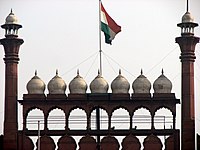Independence Day (India)
From Wikipedia, the free encyclopedia
"Fifteenth of August" redirects here. For other uses, see August 15.
| Independence Day | |
|---|---|
 The national flag of india, on the Red fort in Delhi; a common sight on public and private buildings on national holidays like the 15th of August. | |
| Also called | The Fifteenth of August स्वतन्त्रता दिवस |
| Observed by | India |
| Type | National |
| Significance | The day India became independent from British rule. |
| Date | August 15 |
| Celebrations | Flag hoisting, Parades, Singing patriotic songs, Speech by the Prime Minister, Family reunions, Picnics, Kite flying |
In 1946 the Labour government in Britain, its exchequer exhausted by the recently concluded World War II, and conscious that it had neither the mandate at home, the international support, nor the reliability of native forces for continuing to control an increasingly restless India,[2][3] decided to end British rule of India, and in early 1947 Britain announced its intention of transferring power no later than June 1948.
File:India-map-prepartition1.jpg
Map of India before Partition

Prime Minister Nehru, delivering the speech, Tryst With Destiny, at the house
This file is a candidate for speedy deletion. It may be deleted after Friday, 9 December 2011.
This file is a candidate for speedy deletion. It may be deleted after Friday, 9 December 2011.
Many millions of Muslim, Sikh, and Hindu refugees trekked across the newly drawn borders. In Punjab, where the new border lines divided the Sikh regions in half, massive bloodshed followed; in Bengal and Bihar, where Mahatma Gandhi's presence assuaged communal tempers, the violence was more limited. In all, anywhere between 250,000 and 500,000 people on both sides of the new borders died in the violence.[4] On 14 August 1947, the new Dominion of Pakistan came into being, with Muhammad Ali Jinnah sworn in as its first Governor General in Karachi. At the stroke of midnight, as India moved into August 15, 1947, Jawaharlal Nehru, read out the famous Tryst with destiny speech proclaiming India's independence. India, now a smaller Union of India, became an independent country with official ceremonies taking place in New Delhi, and with Jawaharlal Nehru assuming the office of the first prime minister, and the viceroy, Lord Mountbatten, staying on as its first Governor General.
Contents[hide] |
[edit] Celebrations
The Prime Minister of India hoists the Indian flag on the ramparts of the historical site, Red Fort (लाल क़िला), Delhi, on August 15. This was telecasted live on the National Channel Doordarshan and many other News Channels all over India. Flag hoisting ceremonies and cultural programs take place in all the state capitals. In the cities around the country the national flag is hoisted by politicians in their constituencies. In various private organisations the flag hoisting is carried out by a senior official of that organisation. Schools and colleges around the country organize flag hoisting ceremonies and various cultural events within their premises, where younger children in costume represent their idols of the Independence Era.[edit] See also
[edit] References
- ^ lihu Lauterpacht Editor H. Lauterpacht (1959), International Law Reports, 22, Cambridge University Press, p. 147, ISBN 9780949009364, http://books.google.com.ph/books?id=OrMErqyDdvEC.
- ^ Hyam 2007, p. 106 Quote:By the end of 1945, he and the Commander-in-chief, General Auckinleck were advising that there was a real threat in 1946 of large scale anti-British Disorder amounting to even a well-organised rising aiming to expel the British by paralysing the administration. Quote:...it was clear to Attlee that everything depended on the spirit and reliability of the Indian Army:"Provided that they do their duty, armed insurrection in India would not be an insolube problem. If, however, the Indian Army was to go the other way, the picture would be very different...and there Quote:...Thus, Wavell concluded, if the army and the police "failed" Britain would be forced to go. In theory, it might be possible to revive and reinvigorate the services, and rule for another fifteent to trwenty years, but:It is a fallacy to suppose that the solution lies in trying to maintain status quo. We have no longer the resources, nor the necessary prestige or confidence in ourselves.
- ^ Brown 1994, p. 330 Quote: "India had always been a minority interest in British publicity life; no great body of public opinion now emerged to argue that war-weary and impoverished Britain should send troops and money to hold it against its will in an empire of doubtful value. By late 1946 both Prime Minister and Secretary of State for India recognized that neither international opinion no their own voters would stand for any reassertion of the raj, even if there had been the men, money, and administrative machinery with which to do so." Template:HHarvnb Quote: "With a war weary army and people and a ravaged economy, Britain would have had to retreat; the Labour victory only quickened the process somewhat." Metcalf & Metcalf 2006, p. 212 Quote: "More importantly, though victorious in war, Britain had suffered immensely in the struggle. It simply did not possess the manpower or economic resources required to coerce a restive India."
- ^ (Khosla 2001, p. 299)


No comments:
Post a Comment